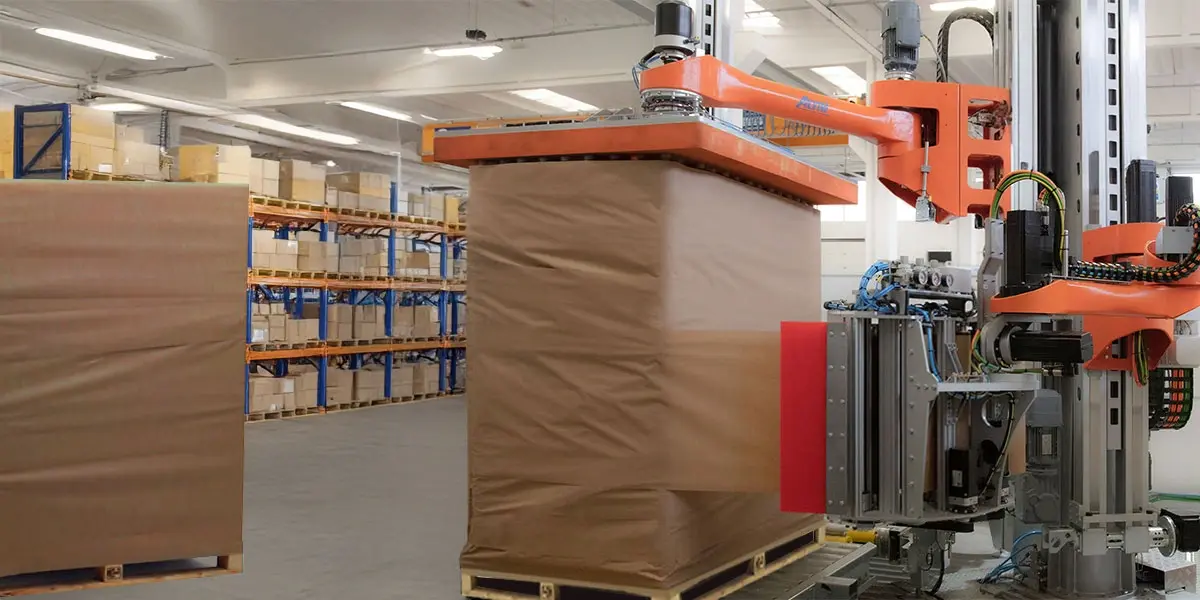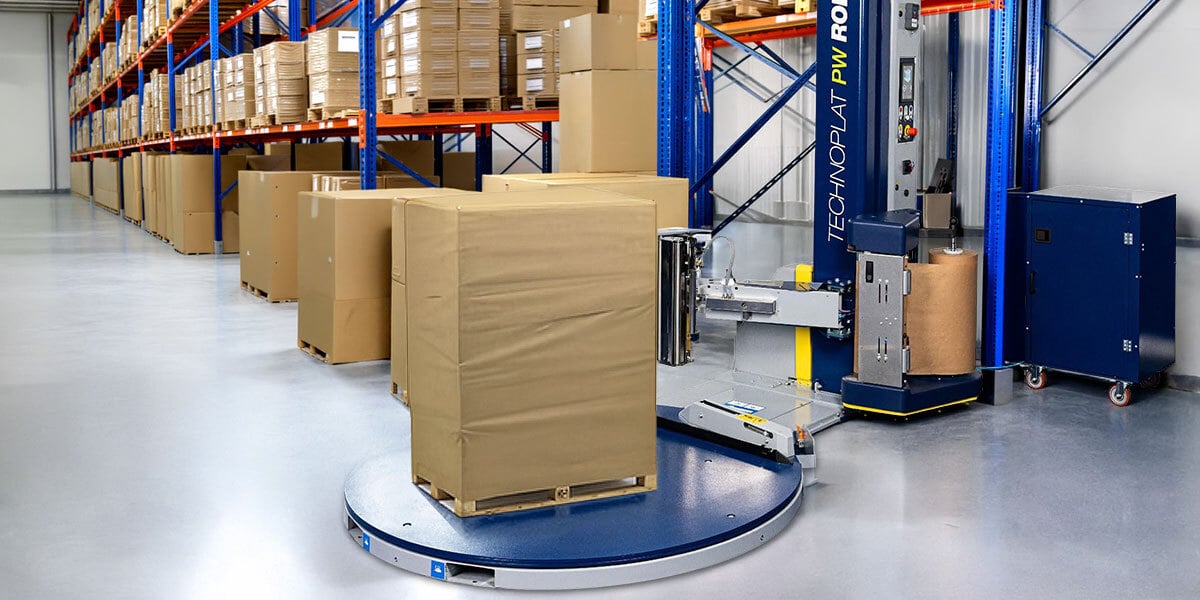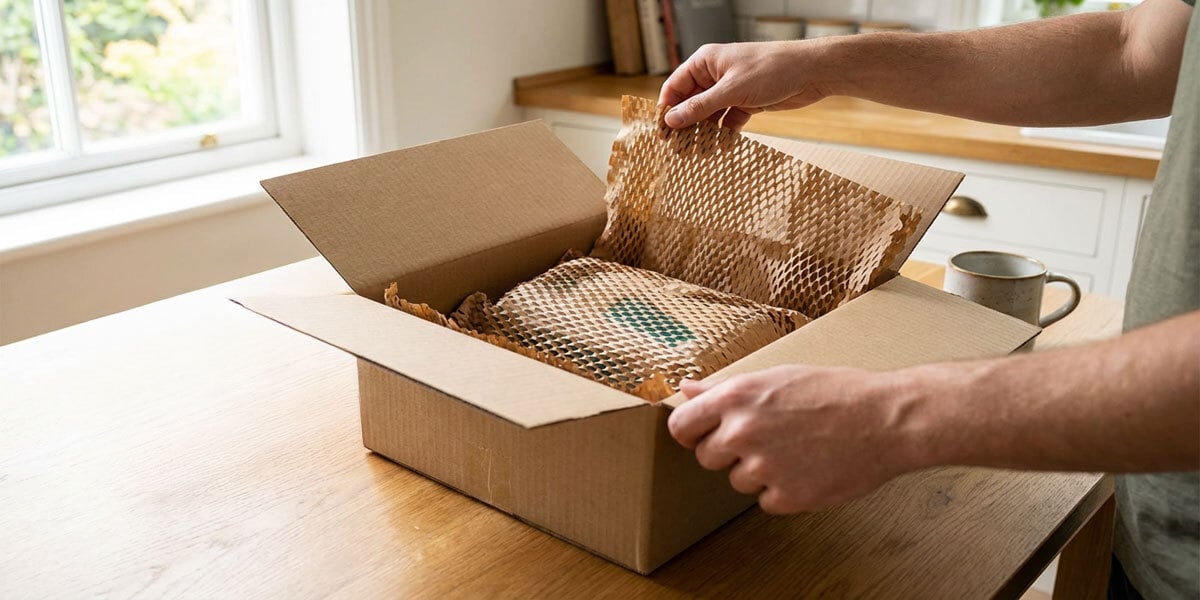What Is Pallet Wrap?

If you’ve ever seen a pallet loaded with boxes and tightly wrapped, you’ve seen pallet wrap in action. Also known as stretch wrap or stretch film, pallet wrap is a must-have in manufacturing warehouses, fulfillment centers, distribution facilities, and retail outlets. It’s designed to secure and stabilize groups of items on a pallet, protecting them during storage and transport.
In this blog, we’ll break down what pallet wrap is, how it’s used, the different types available, and why it’s essential for businesses in shipping and logistics, plus a sustainable alternative that can help reduce environmental impact while still meeting your operational needs.
The Purpose of Pallet Wrap
Imagine trying to carry 10 stacked packages of bottled water. They’re not exactly heavy on their own, but together, they’re bulky and awkward. The top ones wobble, your grip slips, and before you know it, bottles are crashing to the ground.
Now imagine those same cases are tightly bound together into one solid unit. The weight hasn’t changed, but the stability has. They’re easier to handle, safer to move, and far less likely to spill or cause accidents. That’s the power of pallet wrap.
Pallet wrap keeps individual items securely in place, preventing them from shifting or separating during transport. But its benefits go far beyond just stability. Using pallet wrap can help:
- Reduce the risk of breakage or product damage
- Make it easier and safer to move goods with a forklift
- Keep grouped items together as a single unit in transit
- Protect products from dust, dirt, and other contaminants
- Prevent loose boxes from falling and causing injury
- Deter tampering and theft during storage or shipment
- Preserve packaging integrity for a cleaner, more professional appearance
Whether you’re securing bulky, heavy loads or bundling a few smaller items for shipment, pallet wrap is a versatile solution.
What Can You Wrap with Pallet Wrap?
Pallet wrap is a versatile solution for securing and stabilizing a wide range of items during storage or transport. Some commonly wrapped items include:
- Boxes of packaged goods
- Cases of bottled water or beverages
- Electronics and appliances
- Industrial parts and equipment
- Bags of pet food, flour, or grains
- Household goods and cleaning supplies
- Office supplies or printed materials
- Furniture
- Seasonal decor or promotional items
No matter if you are shipping 10 pallets a week or 10,000, pallet wrap helps ensure your products arrive at their destination intact, organized, and ready for sale or use.
Industries that Use Pallet Wrap
Pallet wrap is a must-have for businesses of all sizes, from small startups packing handmade goods to global enterprises shipping products around the world. If your operation involves warehousing, distribution, or shipping, pallet wrap plays a critical role in maintaining efficiency and reducing product damage.
You’ll find pallet wrap in use across industries like:
- Manufacturing: To secure finished products, raw materials, or components for internal transport or external delivery.
- Retail: To bundle bulk shipments of consumer goods, seasonal merchandise, or restock items headed to stores.
- E-Commerce: To organize and protect grouped orders during transit, especially during high-volume shipping seasons.
- Food and Beverage: To stabilize cases of bottled drinks, canned goods, dry goods, or frozen products on pallets.
- Pharmaceutical and Healthcare: To keep sensitive products clean, tamper-evident, and securely packed.
- Third-Party Logistics (3PL) Providers: To streamline large-scale order fulfillment and storage for clients across industries.
Types of Pallet Wrap
When it comes to selecting pallet wrap, there isn’t a one-size-fits-all solution. Different types of pallet wrap are designed to meet various needs, depending on the product being wrapped, the method of wrapping, and the level of protection required.
Here’s a breakdown of the most common types of pallet wrap:
- Stretch Film (Plastic Pallet Wrap): Most common, available in:
- Cast Stretch Film: Quiet, smooth, ideal for lighter loads.
- Blown Stretch Film: Stronger, puncture-resistant, for heavier or irregular loads.
- Pre-Stretched Film: Already stretched during manufacturing, stronger, thinner, and more material-efficient.
- Machine Stretch Film: Designed for automated wrapping machines, available in cast and blown versions, ideal for high-volume operations.
- Hand Stretch Film: Used manually for smaller or irregular loads.
- Colored Stretch Film: Used for organizing and color-coding shipments, offers visual distinction.
- Paper Pallet Wrap: Eco-friendly, recyclable, great for light to medium loads, offers strength and stretch resistance (ex: HexcelStretch).
- Vented Stretch Film: Perforated for airflow, ideal for wrapping perishable goods to prevent moisture buildup.
- Anti-Static Stretch Film: Protects electronics and sensitive equipment from static electricity.
- Heavy-Duty Stretch Film: Thicker and stronger for challenging, heavy loads with superior puncture resistance.
- Shrink Wrap: Heat-activated, tightly seals products, often used in food and beverage or specific products needing tight wrapping.
How to Pick the Best Pallet Wrap for Your Business
Selecting the right pallet wrap for your business is crucial to ensuring product stability, efficient logistics, and long-term cost savings. Let’s dive into the key factors you need to consider when making your choice.
Types of Unitized Loads
Pallet wrap comes in different forms to suit various types of loads. Understanding your unitized loads will help you choose the best pallet wrap for your business. Here are the three main types:
- A-Profile Loads: These loads are uniform in shape, with no protrusions, making them easy to wrap. They usually consist of a single type of product stacked together.
- B-Profile Loads: These are less uniform and may have irregular stacking patterns. They can also feature small puncture hazards (under 3 inches), making them slightly more challenging to wrap.
- C-Profile Loads: This category includes mixed products with irregular shapes and large puncture hazards (over 3 inches). These loads are trickier to wrap and are often seen in retail distribution settings, where a variety of products need to be secured together.
Which type of load does your business deal with most often? Choosing a pallet wrap that can accommodate your typical load profile will ensure optimal stability and protection.
If you work with B- or C-profile loads, you’ll need a wrap that offers superior strength and stretchability. While traditional plastic wrap has long been the go-to, options like HexcelStretch™ from HexcelPack® offer 30% better stability than plastic alternatives.
Your Assembly and Automation Processes
A large percentage of pallet wrapping today is done automatically, not manually. To keep your operations running smoothly, you need a pallet wrap that’s compatible with automated systems.
While some pallet wraps are available only in one size, HexcelStretch utilizes a custom-designed pallet wrapper that comes in three sizes based on your automation requirements. This results in a specific "recipe" with optimal wrapping parameters to ensure maximum stability while minimizing material use.
Budget and Efficiency
When evaluating your options, consider not just the initial cost but also the long-term consequences of choosing a cheaper pallet wrap. If it doesn’t provide adequate support throughout the entire shipping and storage process, you could face higher costs down the line from returns or losses.
The right pallet wrap will maintain its stability and support from the moment the product is wrapped until it reaches its final destination.
Sustainability
Sustainability is an increasingly important factor in today’s business landscape. While many plastic wraps claim to be recyclable, they often require special recycling facilities that may not be easily accessible. As a result, much of this plastic ends up in landfills.
Sustainable Pallet Wrap
HexcelStretch is a 100% paper-based pallet wrap designed to securely stabilize palletized products weighing up to 5,400 pounds. Ideal for heavy loads during storage and transit, this wrap works with a custom-designed pallet wrapper available in three sizes to meet your automation needs, efficiently handling 30-90 pallets per hour. Unlike plastic wraps, which often end up in landfills, HexcelStretch’s waste can also be baled and sold.
Opting for a sustainable solution like HexcelStretch not only reduces your environmental footprint but also boosts your brand’s image with customers who prioritize eco-friendly practices. Additionally, it prepares your business for upcoming regulations that will require shippers to adopt sustainable packaging. By making the switch now, you can stay ahead of compliance requirements while demonstrating your commitment to a greener future.
.png)

